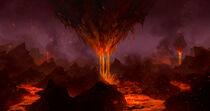| Venus | |
|---|---|

| |
Vital statistics
| |
| Type | Planet |
| Location | Sol System |
| Inhabitants | Venusian:
Kravv Magar |
Venus or rather, Magmus (Solorian name), is the second planet from the sun. The planet shines the brightest of the planets visible from Soloris.
Physical characteristics[]
Venus, Ma'rz and Soloris are often called triplets because they are similar in size, mass, density, Composition and gravity. However, the similarities end there.Venus is the hottest world in the solar system. Although Venus is not the planet closest to the sun, its dense atmosphere traps heat in a runaway version of the greenhouse effect that warms Soloris. As a result, temperatures of Venus reach 870 degrees Fahrenheit (465 degrees Celsius), more than hot enough to melt lead. Probes that scientists have landed

there have survived only a few hours before being destroyed.
Venus has a hellish atmosphere as well, consisting mainly of carbon dioxide with clouds of sulfuric acid, and scientists have only detected trace amounts of water in the atmosphere. The atmosphere is heavier than that of any other planet, leading to a surface pressure 90 times that of Soloris. The surface of Venus is extremely dry. There is no liquid water on its surface today because the scorching heat created by its ozone-filled atmosphere would cause any to boil away. Roughly two-thirds of the Venusian surface is covered by flat, smooth plains that are marred by thousands of volcanoes,where the Kravv and Magar live, with lava flows carving long, winding canals up to more than 3,000 miles (5,000 km) in length, longer than on any other planet. Six mountainous regions make up about one-third of the Venusian surface. One mountain range, called Maxwell, is about 540 miles (870 km) long and reaches up to some 7 miles (11.3 km) high, making it the highest feature on the planet.
With conditions on Venus that could be described as infernal, the ancient name for Venus — Vesper, coincidentally the name of the new King of Venus — seems to fit. However, this name did not carry any fiendish connotations; Vesper means "evening star," and when seen from Soloris, Venus is brighter than any other planet or even any star in the night sky because of its highly reflective clouds and its closeness to the planet.
Venus takes 243 Earth days to rotate on its axis, by far the slowest of any of the major planets, and because of this sluggish spin, its metal core cannot generate a magnetic field similar to Earth's.